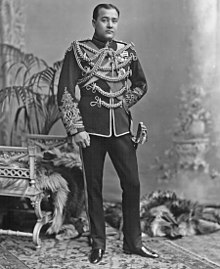Koch dynasty
Koch Kingdom Koch Dynasty | |||||||||||||||
|---|---|---|---|---|---|---|---|---|---|---|---|---|---|---|---|
| 1515–1949–1956 | |||||||||||||||
|
Flag of Sanskrit (for religious and court usage) | |||||||||||||||
| Religion | Hinduism Other ethnic religion[5] | ||||||||||||||
| Government | hereditary monarchy | ||||||||||||||
| Maharaja | |||||||||||||||
• 1515–1540 | Biswa Singha | ||||||||||||||
• 1540–1587 | Nara Narayan | ||||||||||||||
• 1581–1603 | Raghudev | ||||||||||||||
• 1586–1621 | Lakshmi Narayan | ||||||||||||||
• 1922–1947 | Jagaddipendra Narayan | ||||||||||||||
| Historical era | British India | 1775 | |||||||||||||
• Joined India Union | 1949–1956 | ||||||||||||||
| Currency | Narayani | ||||||||||||||
| |||||||||||||||
| Today part of | India Bangladesh Bhutan | ||||||||||||||
| Part of a series on the |
| History of Assam |
|---|
 |
| Categories |
The Koch dynasty (
The dynasty split into three among the descendants of Biswa Singha's three sons; two antagonistic branches
Etymology
The name Koch denotes a matrilineal ethnic group to which Biswa Singha's mother belonged;[8] and the king as well as most of the population of the kingdom (Koch Bihar) belonged to the Koch community.[9]
History
Historical background
After the fall of the
Emergence of the Koch power
It was in this context that a number of independent Koch tribes were united under a leader named Hajo, who occupied Rangpur and Kamrup.[12] The Koches, spreading towards the southern plains, were able to ally with other tribal groups.[13] Among various factors, the shift from slash-and-burn cultivation to settled cultivation and the breakdown of tribal clan-based relations are given as factors that contributed to the growth of Koch power.[14]
As part of these alliances Hajo's daughter Hira married Hariya Mandal, a member of the


Consolidation of power under Bisu
He sought the alliance of tribal chiefs,[24][25] against the more powerful Baro-Bhuyans and began his campaign around 1509.[26] Successively, he defeated the Bhuyans of Ouguri, Jhargaon, Karnapur, Phulaguri, Bijni and Pandunath (Pandu, in Guwahati).[27] He was particularly stretched by the Bhuyan of Karnapur, and could defeat him only by a stratagem during Bihu.
In some records Bisu moved his capital from Chikana to Hingulabas (near present-day
The Koch dynasty in Kamata was one of several tribal formations that developed into statehoods around 15th century in
Sanskritisation
At his coronation Bisu adopted Hinduism and the name Biswa Singha.
This process of hinduisation was much slower in the lower strata of the society,[39] the king Biswa Singha with his tribal origin claimed Rajbanshi kshatriya status,[40] the lower class Koch took this name after the 18th century.[41]
Zenith
Biswa Singha's two sons, Naranarayan and Shukladhwaj (
Later, Nara Narayan made Raghudev, the son of Chilarai, the governor of Koch Hajo, the eastern portion of the country. After the death of Nara Narayan, Raghudev declared independence. The division of the Kamata kingdom into Koch Bihar and Koch Hajo was permanent.
Branches
Rulers of undivided Koch kingdom
- Biswa Singha (1515-1540)
- Nara Narayan (1540-1586)
Rulers of Koch Bihar

- Lakshmi Narayan
- Bir Narayan
- Pran Narayan
- Basudev Narayan
- Mahindra Narayan
- Roop Narayan
- Upendra Narayan
- Devendra Narayan
- Dhairjendra Narayan
- Rajendra Narayan
- Dharendra Narayan
- Harendra Narayan
- Shivendra Narayan
- Narendra Narayan
- Nripendra Narayan[50]
- Rajendra Narayan II
- Jitendra Narayan (father of Gayatri Devi)
- Jagaddipendra Narayan (brother of Gayatri Devi)
- Virajdendra Narayan
Rulers of Koch Hajo
- Raghudev (son of Chilarai, nephew of Nara Narayan)
- Parikshit Narayan
Rulers of Darrang
The
- Balinarayan (brother of Parikshit Narayan)
- Mahendra Narayan
- Chandra Narayan
- Surya Narayan
Rulers of Beltola
| History of South Asia | |
|---|---|
 | |
| (330–323 BC) | |
| Maurya Empire | (321–184 BC) |
| Seleucid India | (312–303 BC) |
| Sangam period | (c. 600 BC – c. 300 AD) |
| Pandya Empire | (c. 300 BC – AD 1345) |
| Chera Kingdom | (c. 300 BC – AD 1102) |
| Chola Empire | (c. 300 BC – AD 1279) |
| Pallava Empire | (c. 250 AD – AD 800) |
| Maha-Megha-Vahana Empire | (c. 250 BC – c. AD 500) |
| Parthian Empire | (247 BC – AD 224) |



